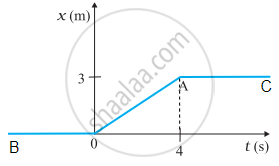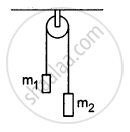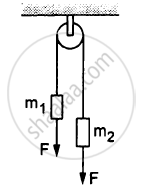Advertisements
Advertisements
प्रश्न
The below figure shows the position-time graph of a particle of mass 4 kg.
- What is the force on the particle for t < 0, t > 4 s, 0 < t < 4 s?
- What is the impulse at t = 0 and t = 4 s? (Consider one-dimensional motion only.)

उत्तर

- For t < 0
For t<0, the graph of position versus time is denoted as BO, which indicates that the displacement of the particle is zero, i.e., the particle is stationary at the origin. Consequently, the force exerted on the particle must be zero. - For t > 4 s
For t>4 s, the position-time graph segment AC runs parallel to the time axis, indicating that the particle maintains a position 3 metres from the origin, implying it is stationary. Therefore, the force acting on the particle is zero. - For 0 < t < 4
Between 0 < t < 4 s, the position-time graph labelled OA displays a constant slope, which indicates that the velocity of the particle remains constant during this interval, meaning the particle has zero acceleration. Consequently, the force on the particle must be zero.
- For t < 0
- At t = 0
Impulse = Change in momentum
= mv – mu
Mass of the particle, m = 4 kg
Initial velocity of the particle, u = 0
Final velocity of the particle, `v = 3/4 "m/s"`
∴Impulse = `4(3/4 - 0) = 3 kg "m/s"`
At t = 4 s
Initial velocity of the particle, `u = 3/4 "m/s"`
Final velocity of the particle, v = 0
∴ Impulse = `4(0-3/4)` = -3 kg m/s
APPEARS IN
संबंधित प्रश्न
If the tension in the cable supporting an elevator is equal to the weight of the elevator, the elevator may be
(a) going up with increasing speed
(b) going down with increasing speed
(c) going up with uniform speed
(d) going down with uniform speed
Find the reading of the spring balance shown in the following figure. The elevator is going up with an acceleration g/10, the pulley and the string are light and the pulley is smooth.

In a simple Atwood machine, two unequal masses m1 and m2 are connected by a string going over a clamped light smooth pulley. In a typical arrangement (In the following figure), m1 = 300 g and m2 = 600 g. The system is released from rest. (a) Find the distance travelled by the first block in the first two seconds; (b) find the tension in the string; (c) find the force exerted by the clamp on the pulley.

In the following figure, m1 = 5 kg, m2 = 2 kg and F = 1 N. Find the acceleration of either block. Describe the motion of m1 if the string breaks but F continues to act.

Use Newton's second law of motion to explain the following instance :
An athlete prefers to land on sand instead of hard floor while taking a high jump .
The linear momentum of a body of mass m moving with velocity v is :
A force of 10 N acts on a body of mass 2 kg for 3 s, initially at rest. Calculate : The velocity acquired by the body
Calculate the velocity of a body of mass 0.5 kg, when it has a linear momentum of 5 Ns.
ame the law of motion which gives the definition of force.
What do you mean by linear momentum of a body? A force causes an acceleration of 10 ms-2 in a body of mass 1 kg. What acceleration will be caused by the same force in a body of mass 4 kg?
